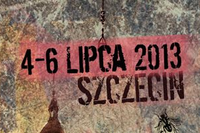
14th Festival - BONDS OF CULTURE
4th - 6th JULY, 2013
GROUPS AND ARTISTS

4th - 6th JULY, 2013
GROUPS AND ARTISTS
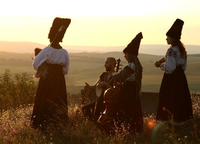
The name DakhaBrakha means "give/take" in the old Ukrainian language. The band blends music and theatre, experiments with traditional Ukrainian melodies, adds elements of world folk into their music. Accompanied by Indian, Arabic, African, Russian and Australian traditional instrumentation, the quartet's astonishing vocal range creates a deep experience uniting musicians and the public, inspiring "cultural and artistic liberation".
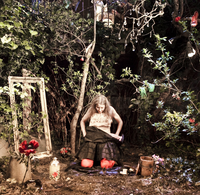
The ensemble is world known for its improvisations in non-theatrical surroundings, absurd black humour and metaphorical subtlety. The world of Krepsko is full of eccentric characters and poetic playfulness. Their performances almost never use a verbal language, but have in common a slightly twisted and tragicomical way of looking at even quite ordinary things. Vegetable Growing for Amourteurs is a site-specific project telling a story of a man, a woman, a house that used to be and a garden that will grow to be.
Mayim Alpert of Krepsko and Ville Niska create a little band with a big sound. Jazz, punk, balkan, noise, horns, guitars, drums, vocals and live looping conjure up thick soundscapes full of humor and fantasy.
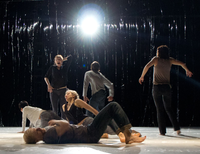
Liquid Loft was founded by a choreographer, a musician, a dancer and a dramaturgue. This interconnection of various contemporary art forms enabled them to create their own, distinctive visual language, in which they question the place of a human in the technological civilization. Innovative stage-set and choreographical approach in their performances have earned Liquid Loft international recognition and awards. In the piece Mush:Room various conceptions of time and the speed by which it passes by, are analyzed under the magnifying glass of dance and choreography. We find that our everyday hope for the ever and all-unexpected, is repeatable itself.
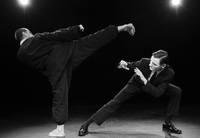
Eight actors of Music and Theatre Academy of Vilnius embarks on a campaign against a increasing emptiness in Lithouanian theatre. Hoping to find a contemporary audience, to understand them and make a connection with them, No Theatre goes out onto the streets, improvises gigs in public spaces, leaving in all cases the right to interpret to the spectator. Full of acoustic music, dance and poetic, surreal scenes, No Concert is a collage of thoughts and acts that engage the public into a strange, exaggerated world which is nonetheless, in some deep way, intimately familiar.
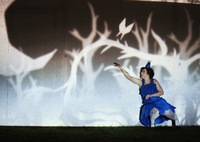
"Sensitivity of a space" is a distinctive feature of this company, founded in 2000. Their actions and socio-artistic experiments often take place in "non-theatrical" environment. Their performances allow the space for the autonomous reactions and choices, thus they engage the spectators completely - their bodies, memories and imagination. Multimedia performance Cykl confronts our need for a linear perception of time with the force of regularity and repetition that show up through our subconscious importunities and imagery of the dreams we've all been sharing since forever.
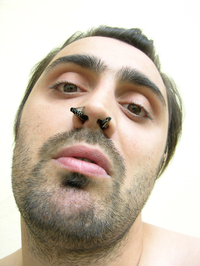
His performances provoke a blend of emotions: they entertain, horrify, surprise, but never bore. He can be uncompromising both towards himself and the public - the proof of that is a well documented collection of contusions. Whole life of his has been submit to performance. The CV performance is a shorthand - graphic even - description of a typical path of a human life in our culture. A main prop is a white door, which in the course of a dynamic and funny action, gain a physical load of meanings and symbols.
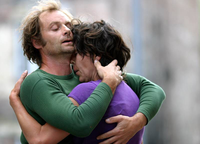
A group of dancers sharing the same desire: to regard public space - in all its richness and dimensions: spatial, historical, social, poetic - as the work place and the site for shows. Movement becomes a way of ephemeral "appropriation" of a territory, which never excludes the "Other": the passer-by, the spectator, the citizen. In Calle Obrapia #4 the geometry of gesture is built based on a relation - with the space and with another person, who has their own history, their own identity, the need for recognition.
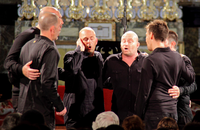
Male vocal group rediscovering traditional poliphonic corsican chants, both secular and religious ones, and creatively using them in their own compositions. The choir of six men sings always standing in a symbolic circle, becoming one sound, one sonorous organism. The singers chose a circle as the symbol of their chants, thus referring to the worldly, religious and spiritual spheres that are interconnecting in polyphonic singing, dissolving the borders between the community and the individual.
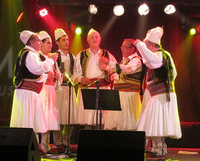
Otherworldly, complex and trance-inducing sounds manifested by the power of the human voice, carrying the emotional weight of centuries of pride, poverty and oppression. Proclaimed a Masterpiece of the Intangible Heritage of Humanity by UNESCO, Albanian polyphonic music is performed during social events (weddings, harvest feast, funerals, religious celebrations). "Iso" refers to the drone accompanying the singing and is typical for the south of Albania. Hysni (Niko) Zela is at the present the most prominent representative of this style and a living legend in his country.
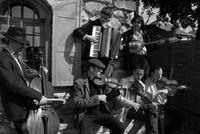
One can say that musicians of this Hungarian ensemble were born into folk music - their parents and teachers instigated the dance-house movement in the mid 1970s. They refined their skills in folk music schools and by playing together with traditional village musicians. Vibrating at the heart of their sound is the pulse of authentic Hungarian folk music interwoven with stylistic elements drawn from elsewhere. Filtering all these elements through their individual personality, the band members have created their own unique sound: exciting, sometimes lyrical, yet always bursting with energy.
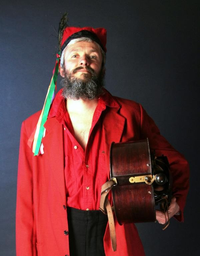
Musician, singer and dancer. His main interests are the tradition of the wandering singers, the processional and round dances. As "Culture Nomads" he and whis wife Alicja travel across Europe with their own Yurt where they present the results of their research and projects in cooperation with artist from the whole world.
Culture Nomads Family Theatre
This time Jacek and Alicja Hałas have created one of a kind music and theatre group and invited to collaboration their children: Julia, Antoni, Jonasz and Jakub. The non-pretensious, tasteful, lyrical piece The clock strikes was inspired by "wertep" - tradition of wandering beggars, singing about the death, love and the wandering.
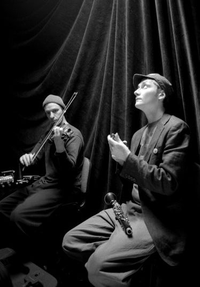
Paweł Szamburski and Patryk Zakrocki's music is a unique blending of seemingly opposite extremes - of noise and silence, pop and contemporary chamber, beauty and ugliness, sophisticated wisdom and pure, naive thoughtlessness - using clarinets, a violin, analogue loopstations and subtle effects. Their soundtrack to Roman Polanski's short films refers among others to Krzysztof Komeda compositions, comments and adds a new voice to the narration, showing the importance of sound and music in a film.
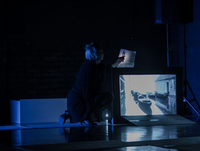
www.kana.art.pl/program_2013_03_02.html
Edyta Waszak is an architect. Simultanously for years she has been looking in the stage space for the ideas for a contemporary form of dance theatre. Architecture and dance theatre alike are the arts of space and time. The artist seeks in both of them a liberation from limiting the essence of things to their function of reproducing reality. The piece Mantel has been created when among the testimonies of the pioneers of Gryfino, she encountered the story of Mrs Daniela, deported to Gryfino from Warsaw's neighbourhood as a forced labourer. Following her traces, the artist attempted to define her own path and her places on this shared map.
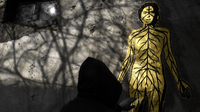
Born in Szczecin, she received a BA in painting from San Francisco State University and an MA in graphic arts from the Szczecin Academy of Art. She lived in Paris, San Francisco and Brooklyn, New York. Winner of artistic awards and scholarships, founder of the independent non-profit art organisation Platerowka. Currently she lives and works in Szczecin. Project Holy! consist of video, book and prints documenting an action in public space, situated in four different places the artist lived in Szczecin.
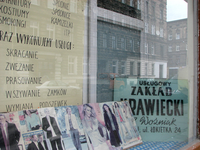
Justyna Machnik is a city guide and author of a radio series "Services to the public". She likes to be where culture and history of Stettin/Szczecin pulses. She looks in the tenement houses and its backyards. Participants of the tour Szczecin at service will enter the world of city's craft shops - their splendour might have diminished under the layers of time, yet their owners still cultivate their professions aa well as the respect for customers.
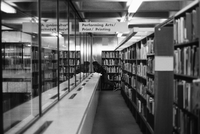
The work of Mette Edvardsen is situated within the performing arts field, also exploring other media or other formats such as video and books. The idea for Time has fallen asleep in the afternoon sunshine comes from the novel "Fahrenheit 451", a future vision of a society where books are forbidden and an underground community of people learn them by heart in order to preserve them for the future.
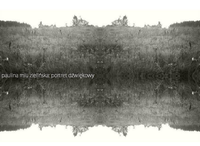
Performer, sound designer, works in the field of sound art. Collaborates with Węgajty theatre, researches therapeutic effects of natural, archaic singing and chants. Apart from that, she conducts her own musical experiments under the name 'Mjol'. Sonoric portrait is a unique composition made up of samples of sounds typical for a given space, registered, edited and performed live in the space of origin.
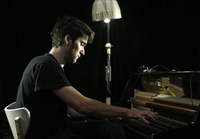
Pianist, composer, winner of many prizes, solo performer, leader and participant of a wide variety of projects - his own sextet Profesjonalizm, band ParisTetris, Warsaw Orchestra of Recreation. His parallel passion is European classical music which he performs in ways and venues not usually associated with this style. His latest project Polonezy is a 10-piece brass band performing polonaises composed by Masecki, that blend esthetics of third-class parade orchestra, 19th century elegance and classicistic composing techniques with sounds drawn from surf rock, hip-hop, samba and jazz.
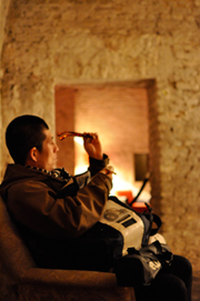
Jun Jun was born in Yokohama, Japan. He started his performing career with mime and contemporary dance. In 1995 he formed "Mizu to Abura" a mime based physical theatre company awarded at major festivals like Edinburgh Festival Fringe. In 2006, JunJun started his own project "JunJun SCIENCE" and had worked with several dancers and companies including Kim Itoh and Monochrome Circus. He is a well known dance teacher, conducting workshop in residencies. As of 2010 he is based in Berlin with a grant from the Japanese Ministry of Culture.
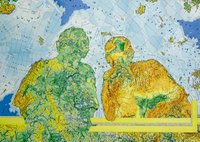
Visual artist working in graphic desing, photography, film, installations, video performances. In the centre of his artistic, social and educational projects is the quest for local identity, he uses photography in its wide sense as means of communication. Treasures of Magellan's widow is a series of pictures/maps, created between years 1999-2008. The ancient cartographers believed that to travel with a map is to confirm the faithfulness of the representation to the World. Yet the true discoverers had no trust in the maps of their predecessors. The joy of discovery is accompanied by fear that we will not be able to return to the starting point, and even if we do, it will not be the same place we left from. The forest of forgotten things refers by its title to the artist's kept memory of his grandfather photographical atelier. The collection of stained-glass pictures made of worn out glass plate negatives is an artistic attempt of facing questions: if I have a memory of an image, does its negative also exist? Or is everything that we remember a negative of what is forgotten? Is the relation between photography and death only a geographical one?